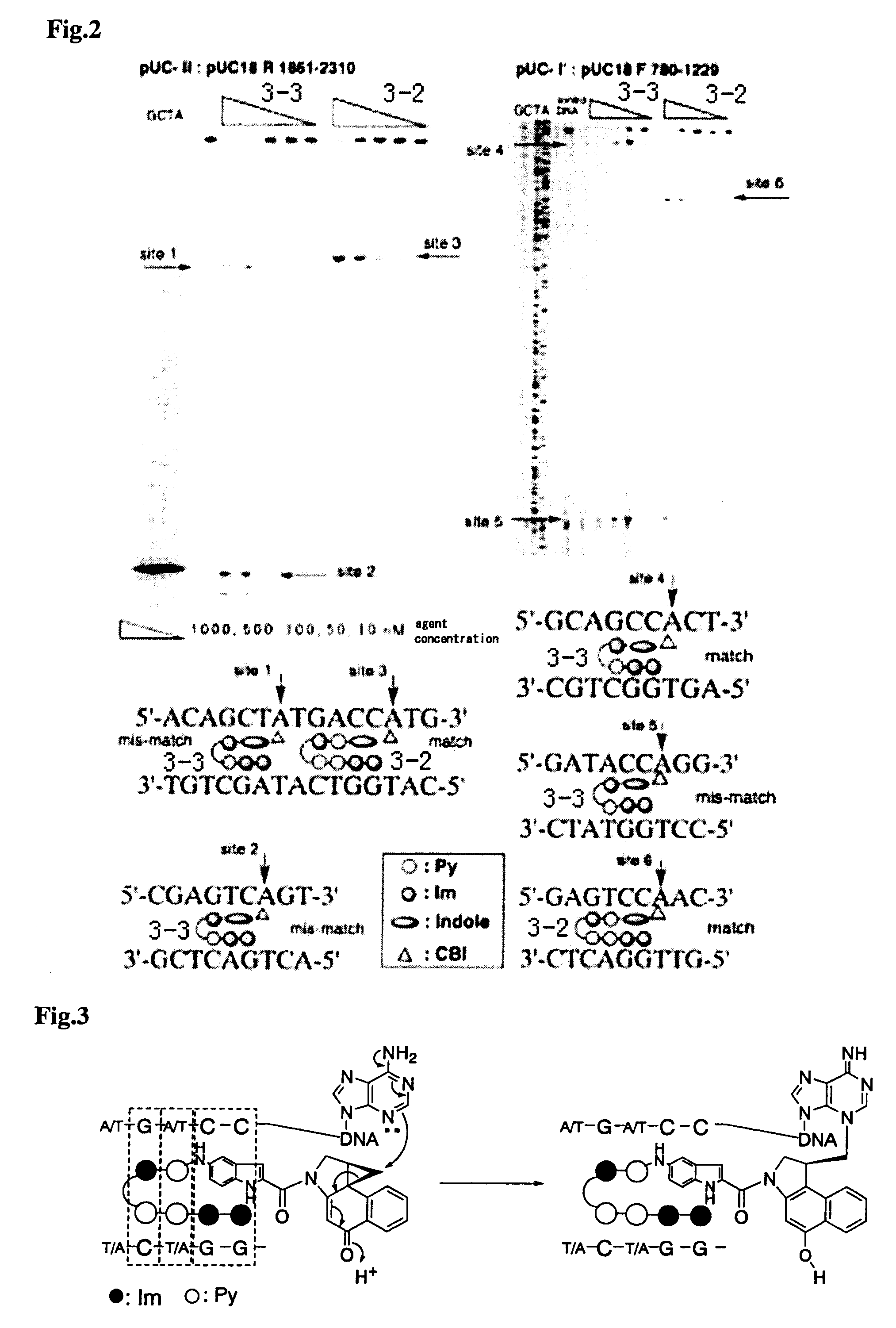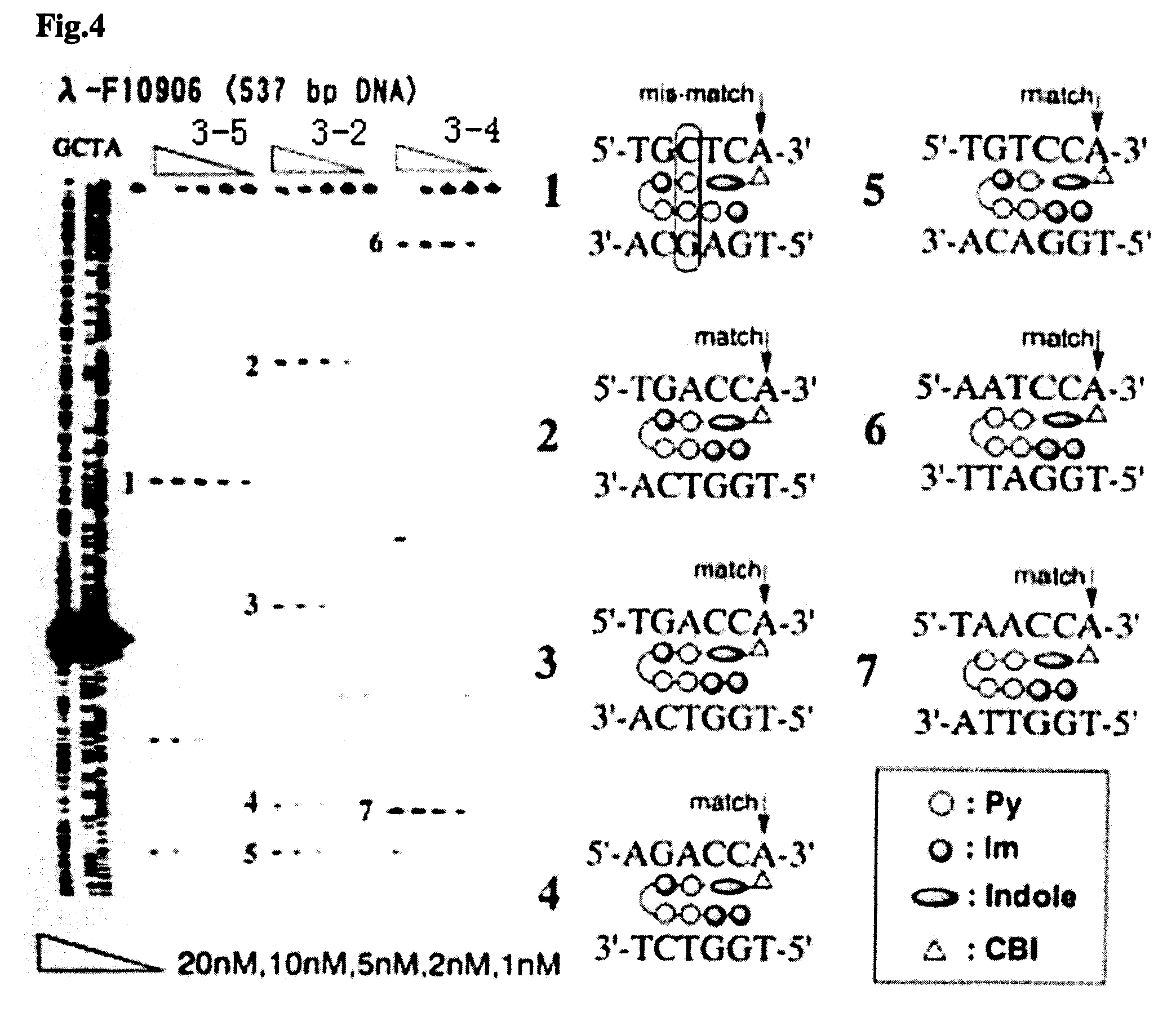Novel indole derivative for alkylating specific base sequence of dna and alkylating agent and drug containing the derivative
a technology of alkylating specific base sequence and indole, which is applied in the field of new indole derivatives, can solve the problems of requiring several days for the completion of the reaction and significantly limited base sequences that can be targeted, and achieves the effect of high application
- Summary
- Abstract
- Description
- Claims
- Application Information
AI Technical Summary
Benefits of technology
Problems solved by technology
Method used
Image
Examples
synthesis example 1 and 2
Synthesis of Compounds (4-1) and (3-1) (Scheme 1)
(1) Synthesis of AcImImCO2H (3-1-1)
[0056] Compound (3-1-1) was synthesized according to a method described in literature [(a) Tao, Z.-F.; Fujiwara, T.; Saito, I.; Sugiyama, H. J. Am. Chem. Soc. 1999, 121, 4961. (b) Tao, Z.-F.; Saito, I.; Sugiyama, H. J. Am. Chem. Soc. 2000, 122, 1602. (c) Bando, T.; Narita, A.; Saito, I.; Sugiyama, H. Chem. Eur. J. 2002, 8, 4781].
[0057]1H-NMR (500 MHz, DMSO-d6) δ: 10.37 (s, 1H; NH), 9.60 (s, 1H; NH), 7.63 (s, 1H; CH), 7.48 (s, 1H; CH), 3.96 (s, 3H; NCH3), 3.93 (s, 3H; NCH3), 2.03 (s, 3H; COCH3);
[0058] ESIMS m / e calcd. for C12H15N6O4 [M++H] 307.1, found 307.3
(2) Synthesis of H2N-Indole-CO2Et (3-1-2)
[0059] Compound (3-1-2) was synthesized from commercially available 5-nitroindole-2-carboxylic acid ethyl ester as a starting material by catalytic reduction with Pd—C in a hydrogen atmosphere. Compound (3-1-2) was used as a starting material for synthesizing compound (3-1-3) without purification.
(3) ...
synthesis example 3
Synthetic Reaction of Compound (3-2) (Scheme 2)
(1) Synthesis of AcImImPyPy-γ-ImPyCO2H (3-2-1)
[0073] Compound (3-2-1) was prepared by an Fmoc solid-phase synthesizer. Purification was performed by HPLC with a Chemcobond 5-ODS—H column (conditions: linear gradient of 0-50% acetonitrile in 0.1% acetic acid, 40 min, 254 nm). The resulting compound was used as a starting material for synthesis.
[0074]1H-NMR (500 MHz, DMSO-d6) δ: 10.32 (s, 1H; NH), 10.29 (s, 1H; NH), 10.23 (s, 1H; NH), 10.00 (s, 1H; NH), 9.91 (s, 1H; NH), 9.32 (s, 1H; NH), 8.02 (s, 1H; NH), 7.56 (s, 1H; Im-H), 7.50 (s, 1H; Im-H), 7.45 (s, 1H; Py-H), 7.44 (s, 1H; Im-H), 7.27 (s, 1H; Py-H), 7.16 (s, 1H; Py-H), 7.14 (s, 1H; Py-H), 6.92 (s, 1H; Py-H), 6.89 (s, 1H; Py-H), 4.00 (s, 3H; NCH3), 3.97 (s, 3H; NCH3), 3.93 (s, 3H; NCH3), 3.84 (s, 3H; NCH3), 3.81 (s, 3H; NCH3), 3.79 (s, 3H; NCH3), 3.19 (m, 2H; CH2), 2.34 (m, 2H; CH2), 2.03 (s, 3H; COCH3), 1.78 (m, 2H; CH2);
[0075] ESI-TOFMS m / e calcd. for C39H45N16O9 [M++H] 881.35, ...
synthesis example 4
Synthesis of AcImImPy-γ-Im-Indole-CBI (3-3)
[0086] Compound (3-3) was synthesized in the same synthetic procedure as that in Synthesis Example 3. Purification was performed by HPLC with a Chemcobond 5-ODS—H column (conditions: linear gradient of 0-50% acetonitrile in 0.1% acetic acid, 40 min, 254 nm). The resulting compound was used for a DNA-alkylating reaction.
[0087] ESI-TOFMS m / e calcd. for C49H48N15O8 [M++H] 974.37, found 974.26
PUM
| Property | Measurement | Unit |
|---|---|---|
| Fraction | aaaaa | aaaaa |
| Fraction | aaaaa | aaaaa |
| Fraction | aaaaa | aaaaa |
Abstract
Description
Claims
Application Information
 Login to View More
Login to View More - R&D
- Intellectual Property
- Life Sciences
- Materials
- Tech Scout
- Unparalleled Data Quality
- Higher Quality Content
- 60% Fewer Hallucinations
Browse by: Latest US Patents, China's latest patents, Technical Efficacy Thesaurus, Application Domain, Technology Topic, Popular Technical Reports.
© 2025 PatSnap. All rights reserved.Legal|Privacy policy|Modern Slavery Act Transparency Statement|Sitemap|About US| Contact US: help@patsnap.com



